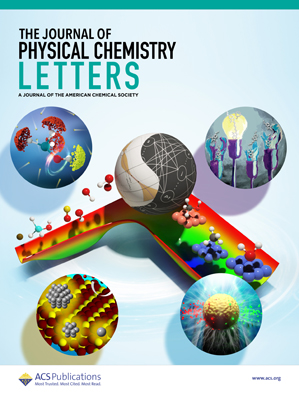氮化硼碳杂化纳米管缺陷致光猝灭研究
IF 4.6
2区 化学
Q2 CHEMISTRY, PHYSICAL
引用次数: 0
摘要
利用266 nm激光同时观察了垂直排列的氮化硼纳米管(VA-BNNT)和光致发光(PL)光谱和氮化硼封装的单壁碳纳米管(SWNT) (VA-SWNT@BNNT)。与h-BN单晶相比,VA-BNNT的PL强度更大,表明VA-BNNT含有更多的缺陷态。VA-SWNT@BNNT在3033和3142 cm-1处有两个多声子拉曼峰,在4639、5859、6905和8293 cm-1处有四个PL峰。值得注意的是,VA-SWNT@BNNT的PL强度比VA-BNNT小20倍。在VA-SWNT中,我们在4677 cm-1处观察到一个额外的拉曼峰,它与VA-SWNT@BNNT的4639 cm-1 PL峰紧密一致,这表明VA-BNNT中的光激发电子可能转移到VA-SWNT@BNNT的VA-SWNT组分内的拉曼过程。第一性原理计算确定了具有取代缺陷的氮化硼双分子层中可能的供体和受体状态(例如,碳取代硼或氮)。这些缺陷状态也与理解BNNT中PL的起源有关。本文章由计算机程序翻译,如有差异,请以英文原文为准。

Quenching of Defect-Induced Photoluminescence in a Boron-Nitride and Carbon Hetero-nanotube
Using a 266 nm laser, we simultaneously observe Raman and photoluminescence (PL) spectra of vertically aligned boron-nitride nanotubes (VA-BNNT) and single-walled carbon nanotubes (SWNT) encapsulated by boron nitride (VA-SWNT@BNNT). The larger PL intensity in VA-BNNT compared to that of the h-BN single crystal suggests that VA-BNNT contains more defect states. VA-SWNT@BNNT exhibits two multiphonon Raman peaks at 3033 and 3142 cm–1 and four PL peaks at 4639, 5859, 6905, and 8293 cm–1. Notably, the PL intensity of VA-SWNT@BNNT is 20 times smaller than that of VA-BNNT. In VA-SWNT, we observe an additional Raman peak at 4677 cm–1, which closely aligns with the 4639 cm–1 PL peak of VA-SWNT@BNNT, suggesting photoexcited electrons in VA-BNNT may transfer to the Raman process within VA-SWNT component of VA-SWNT@BNNT. The first-principles calculations identify possible donor and acceptor states in BN bilayers with substitutional defects (e.g., carbon replacing boron or nitrogen). These defect states are also relevant to understanding the origin of PL in BNNT.
求助全文
通过发布文献求助,成功后即可免费获取论文全文。
去求助
来源期刊

The Journal of Physical Chemistry Letters
CHEMISTRY, PHYSICAL-NANOSCIENCE & NANOTECHNOLOGY
CiteScore
9.60
自引率
7.00%
发文量
1519
审稿时长
1.6 months
期刊介绍:
The Journal of Physical Chemistry (JPC) Letters is devoted to reporting new and original experimental and theoretical basic research of interest to physical chemists, biophysical chemists, chemical physicists, physicists, material scientists, and engineers. An important criterion for acceptance is that the paper reports a significant scientific advance and/or physical insight such that rapid publication is essential. Two issues of JPC Letters are published each month.
 求助内容:
求助内容: 应助结果提醒方式:
应助结果提醒方式:


